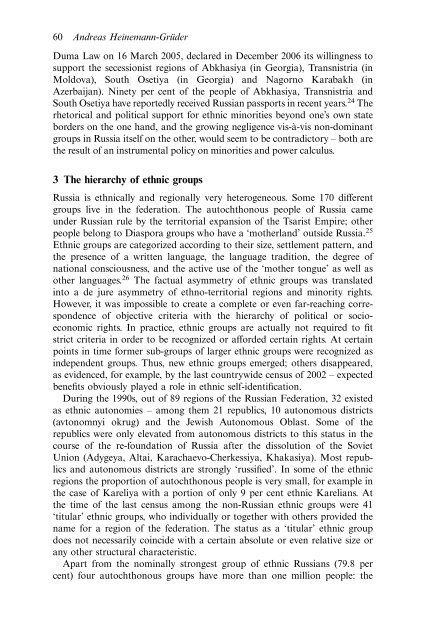Federalism and Local Politics in Russia
Federalism and Local Politics in Russia
Federalism and Local Politics in Russia
Create successful ePaper yourself
Turn your PDF publications into a flip-book with our unique Google optimized e-Paper software.
60 Andreas He<strong>in</strong>emann-GrüderDuma Law on 16 March 2005, declared <strong>in</strong> December 2006 its will<strong>in</strong>gness tosupport the secessionist regions of Abkhasiya (<strong>in</strong> Georgia), Transnistria (<strong>in</strong>Moldova), South Osetiya (<strong>in</strong> Georgia) <strong>and</strong> Nagorno Karabakh (<strong>in</strong>Azerbaijan). N<strong>in</strong>ety per cent of the people of Abkhasiya, Transnistria <strong>and</strong>South Osetiya have reportedly received <strong>Russia</strong>n passports <strong>in</strong> recent years. 24 Therhetorical <strong>and</strong> political support for ethnic m<strong>in</strong>orities beyond one’s own stateborders on the one h<strong>and</strong>, <strong>and</strong> the grow<strong>in</strong>g negligence vis-à-vis non-dom<strong>in</strong>antgroups <strong>in</strong> <strong>Russia</strong> itself on the other, would seem to be contradictory – both arethe result of an <strong>in</strong>strumental policy on m<strong>in</strong>orities <strong>and</strong> power calculus.3 The hierarchy of ethnic groups<strong>Russia</strong> is ethnically <strong>and</strong> regionally very heterogeneous. Some 170 differentgroups live <strong>in</strong> the federation. The autochthonous people of <strong>Russia</strong> cameunder <strong>Russia</strong>n rule by the territorial expansion of the Tsarist Empire; otherpeople belong to Diaspora groups who have a ‘motherl<strong>and</strong>’ outside <strong>Russia</strong>. 25Ethnic groups are categorized accord<strong>in</strong>g to their size, settlement pattern, <strong>and</strong>the presence of a written language, the language tradition, the degree ofnational consciousness, <strong>and</strong> the active use of the ‘mother tongue’ as well asother languages. 26 The factual asymmetry of ethnic groups was translated<strong>in</strong>to a de jure asymmetry of ethno-territorial regions <strong>and</strong> m<strong>in</strong>ority rights.However, it was impossible to create a complete or even far-reach<strong>in</strong>g correspondenceof objective criteria with the hierarchy of political or socioeconomicrights. In practice, ethnic groups are actually not required to fitstrict criteria <strong>in</strong> order to be recognized or afforded certa<strong>in</strong> rights. At certa<strong>in</strong>po<strong>in</strong>ts <strong>in</strong> time former sub-groups of larger ethnic groups were recognized as<strong>in</strong>dependent groups. Thus, new ethnic groups emerged; others disappeared,as evidenced, for example, by the last countrywide census of 2002 – expectedbenefits obviously played a role <strong>in</strong> ethnic self-identification.Dur<strong>in</strong>g the 1990s, out of 89 regions of the <strong>Russia</strong>n Federation, 32 existedas ethnic autonomies – among them 21 republics, 10 autonomous districts(avtonomnyi okrug) <strong>and</strong> the Jewish Autonomous Oblast. Some of therepublics were only elevated from autonomous districts to this status <strong>in</strong> thecourse of the re-foundation of <strong>Russia</strong> after the dissolution of the SovietUnion (Adygeya, Altai, Karachaevo-Cherkessiya, Khakasiya). Most republics<strong>and</strong> autonomous districts are strongly ‘russified’. In some of the ethnicregions the proportion of autochthonous people is very small, for example <strong>in</strong>the case of Kareliya with a portion of only 9 per cent ethnic Karelians. Atthe time of the last census among the non-<strong>Russia</strong>n ethnic groups were 41‘titular’ ethnic groups, who <strong>in</strong>dividually or together with others provided thename for a region of the federation. The status as a ‘titular’ ethnic groupdoes not necessarily co<strong>in</strong>cide with a certa<strong>in</strong> absolute or even relative size orany other structural characteristic.Apart from the nom<strong>in</strong>ally strongest group of ethnic <strong>Russia</strong>ns (79.8 percent) four autochthonous groups have more than one million people: the
















